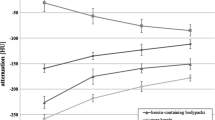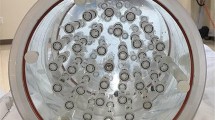Abstract
Objective
To evaluate if heroin and cocaine can be distinguished using dual-energy CT.
Materials and methods
Twenty samples of heroin and cocaine at different concentrations and standardized compression (SC) were scanned in dual-energy mode on a newest generation Dual Energy 64-row MDCT scanner. CT number, spectral graphs, and dual-energy index (DEI) were evaluated. Results were prospectively tested on six original samples from a body packer. Wilcoxon’s test was used for statistical evaluation.
Results
Values are given as median and range. Under SC, the CT number of cocaine samples (−29.87 Hounsfield unit (HU) [−125.85; 16.16 HU]) was higher than the CT number of heroin samples (−184.37 HU [−199.81; −159.25 HU]; p < 0.01). Slope of spectral curves for cocaine was −2.36 HU/keV [−7.15; −0.67 HU/keV], and for heroin, 1.75 HU/keV [1.28; 2.5 HU/keV] (p < 0.01). DEI was 0.0352 [0.0081; 0.0528] for cocaine and significantly higher than for heroin samples (−0.0127 [−0.0097; −0.0159]; p < 0.001). While CT number was inconclusive, all six original packs were correctly classified after evaluation of the spectral curve and DEI. In contrast to the CT number, slope of the spectral curve and DEI were independent of concentration and compression.
Conclusion
The slope of the spectral curve and the DEI from dual-energy CT data can be used to distinguish heroin and cocaine in vitro; these results are independent of compression and concentration in the measured range.





Similar content being viewed by others
References
United Nations Office on Drugs and Crime (2010) World drug report 2010 (United Nations Publication). United Nations Office on Drugs and Crime (UNODOC), Vienna. (2010). Available via http://www.unodc.org/documents/wdr/WDR_2010/World_Drug_Report_2010_lo-res.pdf
Bulstrode N, Banks F, Shrotria S (2002) The outcome of drug smuggling by ‘body packers’—the British experience. Ann R Coll Surg Engl 84(1):35–38
Stewart A, Heaton ND, Hogbin B (1990) Body packing—a case report and review of the literature. Postgrad Med J 66(778):659–661
Traub SJ, Hoffman RS, Nelson LS (2003) Body packing—the internal concealment of illicit drugs. N Engl J Med 349(26):2519–2526. doi:10.1056/NEJMra022719
Claffey M (2002) Stampede of drug mules at Kennedy: after 9/11 lull, heroin and ecstasy busts soar. New York Daily News, May 5, 2002, p 1
de Bakker JK, Nanayakkara PW, Geeraedts LM Jr, de Lange ES, Mackintosh MO, Bonjer HJ (2012) Body packers: a plea for conservative treatment. Langenbeck’s Arch Surg 397(1):125–130. doi:10.1007/s00423-011-0846-z
Silverberg D, Menes T, Kim U (2006) Surgery for “body packers”—a 15-year experience. World J Surg 30(4):541–546. doi:10.1007/s00268-005-0429-7
de Beer SA, Spiessens G, Mol W, Fa-Si-Oen PR (2008) Surgery for body packing in the Caribbean: a retrospective study of 70 patients. World J Surg 32(2):281–285. doi:10.1007/s00268-007-9316-8, discussion 286–287
Wackerle B, Rupp N, von Clarmann M, Kahn T, Heller H, Feuerbach S (1986) Detection of narcotic-containing packages in “body-packers” using imaging procedures. Studies in vitro and in vivo. Röfo 145(3):274–277. doi:10.1055/s-2008-1048932
Schmidt S, Hugli O, Rizzo E, Lepori D, Gudinchet F, Yersin B, Schnyder P, Meuwly JY (2008) Detection of ingested cocaine-filled packets—diagnostic value of unenhanced CT. Eur J Radiol 67(1):133–138. doi:10.1016/j.ejrad.2007.07.017
Hergan K, Kofler K, Oser W (2004) Drug smuggling by body packing: what radiologists should know about it. Eur Radiol 14(4):736–742. doi:10.1007/s00330-003-2091-5
Schaper A, Hofmann R, Ebbecke M, Desel H, Langer C (2003) Cocaine-body-packing. Infrequent indication for laparotomy. Chirurg 74(7):626–631. doi:10.1007/s00104-002-0603-5
Hutchins KD, Pierre-Louis PJ, Zaretski L, Williams AW, Lin RL, Natarajan GA (2000) Heroin body packing: three fatal cases of intestinal perforation. J Forensic Sci 45(1):42–47
Yang RM, Li L, Feng J, Lai SS, Lin BQ, Yu T, Ye XH, Xu YK (2009) Heroin body packing: clearly discerning drug packets using CT. South Med J 102(5):470–475. doi:10.1097/SMJ.0b013e31819ecacc
Ziegeler EGJ, Wirth S, Uhl M, Reiser MF, Scherr M (2012) Computed tomography scout views vs. conventional radiography in body-packers—delineation of body-packs and radiation dose in a porcine model. Eur J Radiol. doi:10.1016/j.ejrad.2012.06.030
Flach PM, Ross SG, Ampanozi G, Ebert L, Germerott T, Hatch GM, Thali MJ, Patak MA (2012) “Drug mules” as a radiological challenge: sensitivity and specificity in identifying internal cocaine in body packers, body pushers and body stuffers by computed tomography, plain radiography and Lodox. Eur J Radiol 81(10):2518–2526. doi:10.1016/j.ejrad.2011.11.025
Poletti PA, Canel L, Becker CD, Wolff H, Elger B, Lock E, Sarasin F, Bonfanti MS, Dupuis-Lozeron E, Perneger T, Platon A (2012) Screening of illegal intracorporeal containers (“body packing”): is abdominal radiography sufficiently accurate? A comparative study with low-dose CT. Radiology 265(3):772–779. doi:10.1148/radiol.12112767
Brogdon BG, Vogel H, Algra PR (2010) Smuggling/border control. In: Brogdon’s forensic radiology, 2nd edn. CRC, pp 297–310. doi:10.1201/b10323-26
Wetli CV, Mittlemann RE (1981) The “body packer syndrome”—toxicity following ingestion of illicit drugs packaged for transportation. J Forensic Sci 26(3):492–500
Booker RJ, Smith JE, Rodger MP (2009) Packers, pushers and stuffers—managing patients with concealed drugs in UK emergency departments: a clinical and medicolegal review. Emerg Med J 26(5):316–320. doi:10.1136/emj.2008.057695
Mandava N, Chang RS, Wang JH, Bertocchi M, Yrad J, Allamaneni S, Aboian E, Lall MH, Mariano R, Richards N (2011) Establishment of a definitive protocol for the diagnosis and management of body packers (drug mules). Emerg Med J 28(2):98–101. doi:10.1136/emj.2008.059717
Goertemoeller S, Behrman A (2006) The risky business of body packers and body stuffers. J Emerg Nurs 32(6):541–544. doi:10.1016/j.jen.2006.07.014
East JM (2005) Surgical complications of cocaine body-packing: a survey of Jamaican hospitals. West Indian Med J 54(1):38–41
Raben AM, Phoa SS, Busch OR, Schultz MJ (2005) Case report of a smuggler’s dinner: carrots and asparagus, or bolitas? Med Sci Monit 11(12):CS79–CS81
Novelline R (ed) (1997) Squire’s fundamentals of radiology, 5th edn. Harvard University Press, Boston
Maurer MH, Niehues SM, Schnapauff D, Grieser C, Rothe JH, Waldmuller D, Chopra SS, Hamm B, Denecke T (2011) Low-dose computed tomography to detect body-packing in an animal model. Eur J Radiol 78(2):302–306. doi:10.1016/j.ejrad.2010.09.004
Pache G, Einhaus D, Bulla S, Baumann T, Langer M, Blanke P (2012) Low-dose computed tomography for the detection of cocaine body packs: clinical evaluation and legal issues. Röfo 184(2):122–129. doi:10.1055/s-0031-1281781
Leschka S, Fornaro J, Laberke P, Blum S, Alkadhi H, Niederer I, Meile C, Hibbeln D, Hausmann R, Wildermuth S, Eisenhart D (2013) Differentiation of cocaine from heroine body packs by computed tomography: impact of different tube voltages and the dual-energy index. J Forensic Radiol Imaging 1(2):46–50. doi:10.1016/j.jofri.2013.03.041
Coursey CA, Nelson RC, Boll DT, Paulson EK, Ho LM, Neville AM, Marin D, Gupta RT, Schindera ST (2010) Dual-energy multidetector CT: how does it work, what can it tell us, and when can we use it in abdominopelvic imaging? Radiographics 30(4):1037–1055. doi:10.1148/rg.304095175
Hartman R, Kawashima A, Takahashi N, Silva A, Vrtiska T, Leng S, Fletcher J, McCollough C (2012) Applications of dual-energy CT in urologic imaging: an update. Radiol Clin N Am 50(2):191–205. doi:10.1016/j.rcl.2012.02.007, v
Johnson TR, Krauss B, Sedlmair M, Grasruck M, Bruder H, Morhard D, Fink C, Weckbach S, Lenhard M, Schmidt B, Flohr T, Reiser MF, Becker CR (2007) Material differentiation by dual energy CT: initial experience. Eur Radiol 17(6):1510–1517. doi:10.1007/s00330-006-0517-6
Manglaviti G, Tresoldi S, Guerrer CS, Di Leo G, Montanari E, Sardanelli F, Cornalba G (2011) In vivo evaluation of the chemical composition of urinary stones using dual-energy CT. AJR Am J Roentgenol 197(1):W76–W83. doi:10.2214/AJR.10.5217
Mongan J, Rathnayake S, Fu Y, Wang R, Jones EF, Gao DW, Yeh BM (2012) In vivo differentiation of complementary contrast media at dual-energy CT. Radiology. doi:10.1148/radiol.12120692
Ruder TD, Thali Y, Bolliger SA, Somaini-Mathier S, Thali MJ, Hatch GM, Schindera ST (2013) Material differentiation in forensic radiology with single-source dual-energy computed tomography. Forensic Sci Med Pathol 9(2):163–169. doi:10.1007/s12024-012-9398-y
Krauss B (2005) The dual-energy index. Siemens Healthcare AG, Siemens Medical 2005
Conflict of interest
The authors declare that they have no conflict of interest.
Author information
Authors and Affiliations
Corresponding author
Additional information
The study was in accordance with local and international legislation.
Rights and permissions
About this article
Cite this article
Grimm, J., Wudy, R., Ziegeler, E. et al. Differentiation of heroin and cocaine using dual-energy CT—an experimental study. Int J Legal Med 128, 475–482 (2014). https://doi.org/10.1007/s00414-014-0980-6
Received:
Accepted:
Published:
Issue Date:
DOI: https://doi.org/10.1007/s00414-014-0980-6




